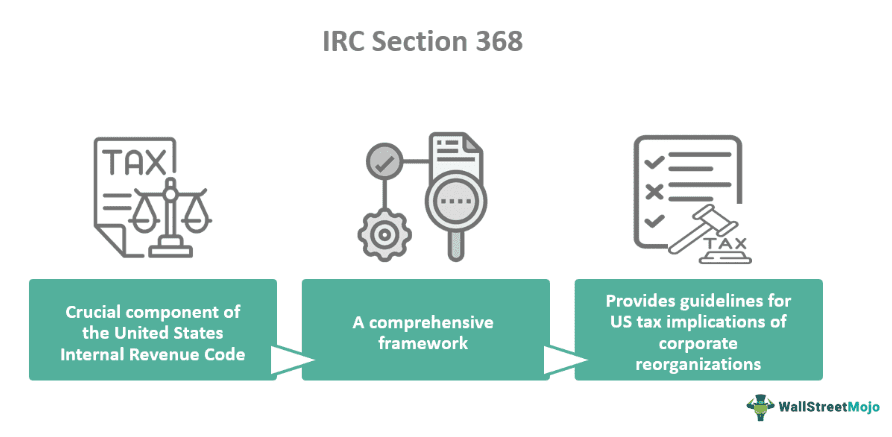Table Of Contents
What Is IRC Section 368?
IRC Section 368 is a crucial element of the U.S. Internal Revenue Code that governs the tax implications of corporate reorganizations. These reorganizations involve the exchange of stock or assets between companies, intending to achieve specific business goals while maintaining continuity for tax purposes.

This section provides a framework for various reorganization types and sets out the conditions under which these transactions qualify for tax-free treatment. It allows companies to rearrange their structures without creating immediate tax liabilities. This structure promotes efficient resource allocation and will enable businesses to grow and adapt to the changing market conditions.
Key Takeaways
- IRC Section 368 is a comprehensive legislative framework established by the United States Internal Revenue Code and it provides a set of guidelines for carrying out tax-free corporate reorganizations.
- This Section outlines the rules and regulations that allow businesses to carry out reorganizations without the burden of significant tax liabilities. It helps enhance corporate flexibility and economic growth.
- The reorganizations comprise several types of transactions, like mergers and acquisitions. This framework assists businesses in reorienting their assets, ownership, and operations to achieve their corporate goals.
- It enables companies to adapt to the evolving market dynamics and boost their operational proficiency.
IRC Section 368 Explained
IRC Section 368 is a vital aspect of the United States Internal Revenue Code that establishes the rules for tax-free corporate reorganizations. These reorganizations encompass various transactions, including mergers, acquisitions, and divisions. The companies restructure their ownership, assets, and operations to meet specific business objectives. This section provides guidelines that enable companies to carry out these reorganizations while minimizing immediate tax liabilities, and promoting corporate flexibility and economic growth.
This framework outlines several types of reorganizations, each with its specific requirements. To comply with these provisions, the companies must carry out the reorganizations if they serve a legitimate business purpose. They should not primarily be driven by tax avoidance. The section acts as an instrument for facilitating corporate restructuring while ensuring a transparent and predictable tax framework. It allows businesses to evolve according to the changing market dynamics and optimize their operational efficiency.
IRC Section 368(a)(1) Subsections A Through G
The IRC Section 368(a)(1) is divided into subsections A through G, where each section explains the distinct categories of the reorganizations. They are as follows:
- Subsection A covers statutory mergers or consolidations, where one corporation is merged into another or two corporations combine to form a new organization. For this reorganization to be tax-free, the target company's shareholders must receive stock in the acquiring company.
- Subsection B provides guidelines for one company acquiring stock from another, resulting in at least 80% ownership. The remuneration exchanged primarily needs to be the acquiring corporation's stock.
- Subsection C involves the acquisition of stock or assets of a target corporation, which is then reorganized into a new corporation. It qualifies for tax-free treatment.
- Subsection D encompasses transfers of assets between corporations in a reorganization where no stock is exchanged. The target corporation's shareholders must receive the acquiring corporation's stock or a mix of its stock and other property.
- Subsection E covers recapitalizations, wherein a corporation changes its structure and exchanges its stock for the stock of a controlled corporation. This exchange should be primarily for voting stock.
- Subsection F comprises reorganizing foreign corporations engaging in trade or business within the United States. It addresses tax-free treatment when the companies meet specific requirements.
- Subsection G provides definitions and rules related to applying these reorganization types. It ensures consistency and proper interpretation.
Tax-Free Reorganizations
Tax-free reorganizations are strategic transactions through which companies can rearrange their ownership, structures, and assets without incurring immediate tax obligations. The IRC Section 368 of the U.S. Internal Revenue Code guides these reorganizations. They are designed to promote business flexibility and growth.
The various types of tax-free reorganizations that exist are as follows:
- Mergers and Consolidations: One company is merged into another, or two companies combine to form a new entity. Shareholders of the target company receive stocks in the acquiring company and qualify for tax-free treatment.
- Stock-for-Stock Acquisitions: A corporation acquires stocks from another in this reorganization, resulting in at least 80% ownership. The exchanged compensation is the acquiring company's stock.
- Assets-for-Stock Exchanges: For this reorganization, stocks or assets of a target company are acquired. The target company is reorganized into a new corporation, thus remaining tax-free.
- Transfer of Assets and Liabilities: This reorganization occurs when assets are transferred between companies. The target shareholders receive the acquiring company's stocks or a combination of its stocks and assets.
Examples
Let us study the following examples to understand this Section:
Example #1
Suppose Apex Software is a successful tech company. It wants to acquire NewLife Ltd., a startup with innovative technology. Apex proposes a stock-for-stock acquisition where it offers the shareholders of NewLife Ltd. the option to exchange their shares for Apex Software shares. The shareholders of NewLife Ltd. agree to the deal, and the acquisition is completed. The transaction meets the requirements of IRC Section 368, which involves the exchange of stock. As a result, the acquisition qualifies for tax-free treatment.
Example #2
On March 23, 2023, Castellum announced that it completed its acquisition of Global Technologies Management Resources. Castellum is a company that provides cybersecurity and electronic warfare services, whereas Global Technologies Management Resources (GTMR) is an engineering, technical, and management services company.
Castellum's revenue run rate after the acquisition reached over $50 million. It was a tax-free reorganization under Section 368 of the Internal Revenue Code. Before this acquisition, Castellum acquired the Lexington Solutions Group in April 2022, which enhanced Castellum's portfolio.

